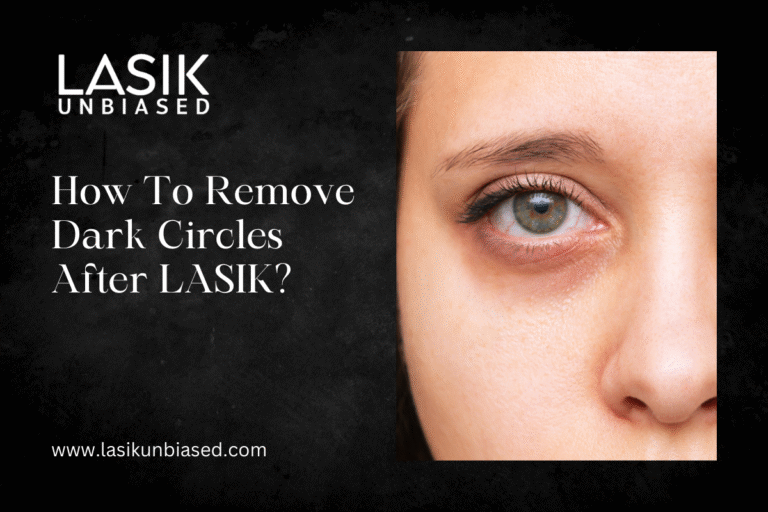Dark circles after LASIK can be managed and reduced through a combination of proper care, hydration, a healthy diet, and adequate rest.
These simple yet effective solutions not only address the dark circles but also enhance your post-surgery recovery.
Under-eye circles can be a concern for many people following LASIK procedures. Although not a direct side effect of the surgery, factors such as eye strain, disrupted sleep, or post-operative fatigue may contribute to their appearance. Understanding why they happen and how to treat them is essential to feeling and looking your best post-surgery. Here’s a comprehensive guide to tackling dark circles after LASIK, helping you feel refreshed and confident.
Understanding Dark Circles Post-LASIK
What causes dark circles after LASIK?
It’s important to note that dark circles after LASIK may not be directly linked to the surgery itself. Instead, factors like stress on the eyes, disrupted sleep patterns, or post-operative fatigue contribute to this condition. The strain experienced during and after the LASIK procedure can sometimes manifest as dark patches around the delicate under-eye area.
Are dark circles after LASIK common?
While dark circles are not a direct or common side effect of LASIK surgery, some individuals may notice mild under-eye shadowing during the recovery phase. This is typically associated with factors such as eye strain, fatigue, or alterations in sleep patterns, rather than the surgical procedure itself. Fortunately, these dark circles are usually temporary and can improve significantly with proper care and attention.
Tips to Remove Dark Circles After LASIK
Give your eyes sufficient rest
One of the primary reasons for dark circles post-LASIK is lack of rest. It is recommended to obtain 7-8 hours of high-quality sleep each night. Sleep allows your body to heal and rejuvenate, reducing the stress on your eyes. Create a sleep-friendly environment by dimming lights, keeping screens away, and wearing an eye mask if necessary.
Quick Tip: Elevate your head slightly with an extra pillow to reduce fluid pooling under the eyes, which can exacerbate dark circles.
Stay hydrated
Dehydration can worsen dark circles. Ensure proper hydration by drinking an adequate amount of water regularly throughout the day. Proper hydration improves circulation and plumps skin, reducing the appearance of shadows under the eyes. Avoid excess consumption of caffeine and alcohol, as these can dehydrate your body further.
Cold compress therapy
A cold compress aids in constricting blood vessels, thereby reducing puffiness and the darkened appearance around the eyes. Here’s how to use it effectively:
- Place a few ice cubes inside a soft towel and wrap them securely.
- Then, place it gently over your closed eyes for 10–15 minutes, taking care not to apply ice directly or too firmly near the eyes to avoid irritation.
- Repeat this remedy twice daily for noticeable improvement.
If ice cubes feel too harsh, chilled cucumber slices or refrigerated tea bags (preferably green tea) can serve as gentler alternatives.
Incorporate a nutrient-rich diet
Post-surgery recovery largely depends on proper nutrition. A diet enriched with vitamin C, vitamin K, and antioxidants promotes healthy skin and reduces dark circles. Include plenty of fresh fruits, dark leafy greens, and nuts in your daily meals. Omega-3 fatty acids found in fish, chia seeds, and walnuts also improve skin elasticity and hydration, minimising those bothersome dark circles.
Prioritise foods such as:
- Oranges, lemons, and berries (high in vitamin C)
- Spinach and kale (rich in vitamin K)
- Almonds and sunflower seeds (loaded with vitamin E)
Avoid excessive screen time
Post-LASIK, your eyes are more sensitive than usual. Extended screen time places undue strain on your eyes, potentially worsening dark circles. Adopt the 20-20-20 rule to reduce eye fatigue. Every 20 minutes, direct your gaze toward an object located 20 feet away for a duration of 20 seconds.
Invest in blue light-blocking glasses or enable the “night mode” setting on devices to ease strain.
Use a gentle under-eye cream
Post-LASIK, your skin might feel sensitive. Opt for hypoallergenic under-eye creams containing ingredients like hyaluronic acid, caffeine, or vitamin C, but only after consulting your ophthalmologist to ensure the products are safe for use during your recovery period. These ingredients target dark circles by improving hydration and brightness. Gently dab the cream under your eyes using your ring finger to avoid pressure.
Quick Pick Recommendation:
- Avoid retinol-based creams in the initial recovery phase unless specifically approved by your doctor, as retinol can irritate sensitive skin around healing eyes.
- Coffee-infused serums (for daytime use) can be a safer, soothing option.
Practice regular eye exercises
Simple eye exercises may help reduce eye strain and improve relaxation, which can indirectly assist in alleviating dark circles caused by fatigue. Here’s an easy exercise you can incorporate into your routine:
- Close your eyes tightly for 5 seconds.
- Open them wide and look upwards.
- Repeat this 5–10 times.
Eye yoga practices, such as gentle circular eye movements, can help relieve visual fatigue, though evidence for improving skin tone is limited.
Protect your eyes from UV rays
Exposure to direct sunlight can darken the under-eye skin. Always wear 100% UV-protected sunglasses when outdoors, especially after LASIK surgery. Complement this with a broad-spectrum sunscreen applied cautiously around the eyes, using formulations specifically designed for the eye area to avoid irritation.
Unprotected exposure can also slow down your recovery. Make UV protection a priority even on overcast days.
Common Mistakes to Avoid
Overusing cosmetic remedies
While makeup can temporarily conceal dark circles, heavy or prolonged use of concealers or foundations, especially if not removed properly, can irritate the skin and potentially interfere with optimal healing post-LASIK. Opt for minimal, breathable coverage if necessary, and always ensure thorough cleansing at the end of the day.
Ignoring stress management
Stress may indirectly delay healing and contribute to fatigue-related dark circles. Managing stress is beneficial for overall recovery and eye comfort post-LASIK. Incorporate stress-relieving techniques like meditation, yoga, or short walks into your daily schedule. They’re not just great for your eyes but your overall health too.
Skipping follow-up appointments
Post-surgery follow-ups are crucial for tracking your healing progress and addressing concerns like lingering dark circles. Regular check-ins with your ophthalmologist can help rule out other complications that might mimic or worsen dark circles.
When to Seek Medical Attention?
If dark circles persist for more than a few weeks despite using the tips above, consult your doctor. Persistent dark circles may be due to underlying issues such as allergies, sinus congestion, fatigue, or post-surgical conditions like dry eye syndrome.
Your ophthalmologist or dermatologist may recommend appropriate treatments, such as prescription creams or medical-grade serums, depending on the cause of the dark circles.
Bright Eyes and Confidence Post-LASIK
Removing dark circles after LASIK is achievable with a combination of care, rest, and lifestyle changes. The key is being consistent with habits that support healing and enhance skin health. Remember, a healthier post-LASIK look isn’t just about lightened under-eyes but improved comfort for your vision and wellbeing overall.
If you’re still concerned about your recovery or need personalised advice, don’t hesitate to consult your eye specialist.


